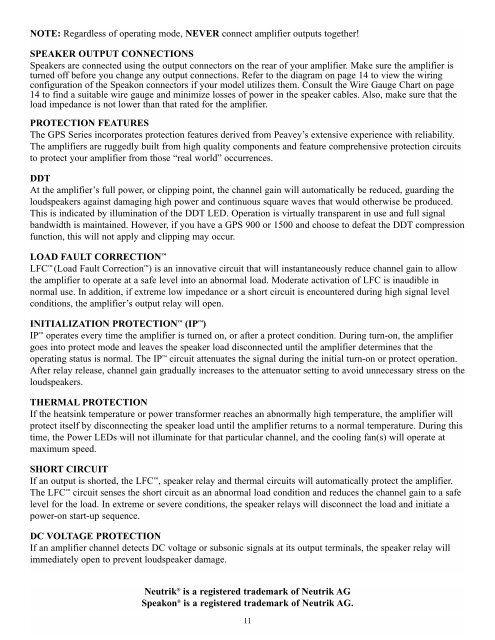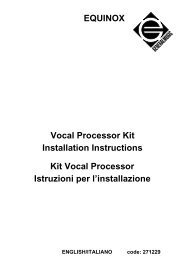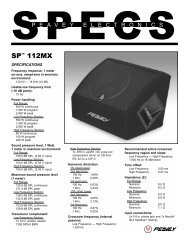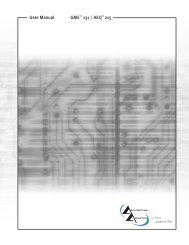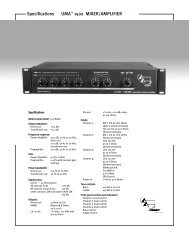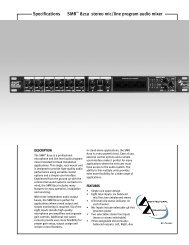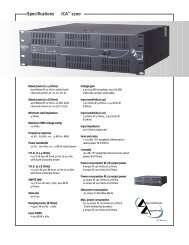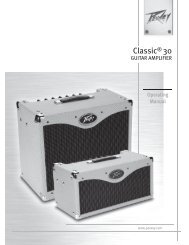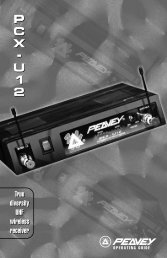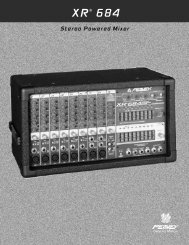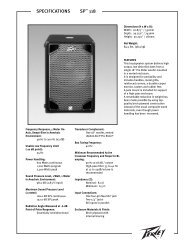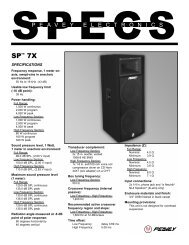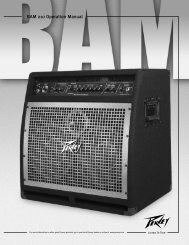GPS Series Amplifiers GPS Series Amplifiers - Peavey
GPS Series Amplifiers GPS Series Amplifiers - Peavey
GPS Series Amplifiers GPS Series Amplifiers - Peavey
You also want an ePaper? Increase the reach of your titles
YUMPU automatically turns print PDFs into web optimized ePapers that Google loves.
NOTE: Regardless of operating mode, NEVER connect amplifier outputs together!<br />
SPEAKER OUTPUT CONNECTIONS<br />
Speakers are connected using the output connectors on the rear of your amplifier. Make sure the amplifier is<br />
turned off before you change any output connections. Refer to the diagram on page 14 to view the wiring<br />
configuration of the Speakon connectors if your model utilizes them. Consult the Wire Gauge Chart on page<br />
14 to find a suitable wire gauge and minimize losses of power in the speaker cables. Also, make sure that the<br />
load impedance is not lower than that rated for the amplifier.<br />
PROTECTION FEATURES<br />
The <strong>GPS</strong> <strong>Series</strong> incorporates protection features derived from <strong>Peavey</strong>’s extensive experience with reliability.<br />
The amplifiers are ruggedly built from high quality components and feature comprehensive protection circuits<br />
to protect your amplifier from those “real world” occurrences.<br />
DDT<br />
At the amplifier’s full power, or clipping point, the channel gain will automatically be reduced, guarding the<br />
loudspeakers against damaging high power and continuous square waves that would otherwise be produced.<br />
This is indicated by illumination of the DDT LED. Operation is virtually transparent in use and full signal<br />
bandwidth is maintained. However, if you have a <strong>GPS</strong> 900 or 1500 and choose to defeat the DDT compression<br />
function, this will not apply and clipping may occur.<br />
LOAD FAULT CORRECTION <br />
LFC (Load Fault Correction ) is an innovative circuit that will instantaneously reduce channel gain to allow<br />
the amplifier to operate at a safe level into an abnormal load. Moderate activation of LFC is inaudible in<br />
normal use. In addition, if extreme low impedance or a short circuit is encountered during high signal level<br />
conditions, the amplifier’s output relay will open.<br />
INITIALIZATION PROTECTION (IP )<br />
IP operates every time the amplifier is turned on, or after a protect condition. During turn-on, the amplifier<br />
goes into protect mode and leaves the speaker load disconnected until the amplifier determines that the<br />
operating status is normal. The IP circuit attenuates the signal during the initial turn-on or protect operation.<br />
After relay release, channel gain gradually increases to the attenuator setting to avoid unnecessary stress on the<br />
loudspeakers.<br />
THERMAL PROTECTION<br />
If the heatsink temperature or power transformer reaches an abnormally high temperature, the amplifier will<br />
protect itself by disconnecting the speaker load until the amplifier returns to a normal temperature. During this<br />
time, the Power LEDs will not illuminate for that particular channel, and the cooling fan(s) will operate at<br />
maximum speed.<br />
SHORT CIRCUIT<br />
If an output is shorted, the LFC , speaker relay and thermal circuits will automatically protect the amplifier.<br />
The LFC circuit senses the short circuit as an abnormal load condition and reduces the channel gain to a safe<br />
level for the load. In extreme or severe conditions, the speaker relays will disconnect the load and initiate a<br />
power-on start-up sequence.<br />
DC VOLTAGE PROTECTION<br />
If an amplifier channel detects DC voltage or subsonic signals at its output terminals, the speaker relay will<br />
immediately open to prevent loudspeaker damage.<br />
Neutrik ® is a registered trademark of Neutrik AG<br />
Speakon ® is a registered trademark of Neutrik AG.<br />
11


